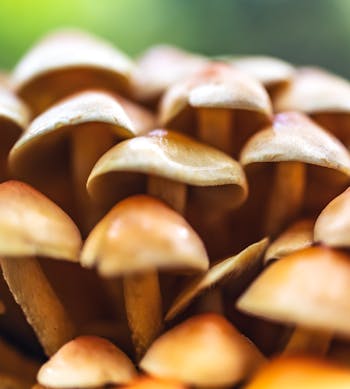Harvesting and processing of mushrooms
General instructions on picking mushrooms
- Carry your harvest in an open basket, if you can, or a cloth or paper bag. At a push, small tupperware boxes…but never a plastic bag, please.
- Take a small knife, and cut every mushroom in half. As well as checking for maggots or other intruders, the flesh of some fungus changes colour when exposed to the air, which can be an identifying factor.
- Take gloves. Some fungal toxins, and the psychotropic substances that are found in a few species, can enter the body through the skin.
- Play safe. If you’re not entirely sure that what you’ve picked is edible, don’t eat it.
- Cook everything you intend to eat. Cook it well – for some that means a long slow casserole, for others a shorter time but in hot oil (or bacon fat).
- It’s worth being cautious the first time you eat a new mushroom. Try a small amount first, on the off chance of allergies and if there are no ill effects (and you like the taste), you can go looking for more, with more confidence.
- It’s worth being cautious the first time you eat a new mushroom. Try a small amount first, on the off chance of allergies and if there are no ill effects (and you like the taste), you can go looking for more, with more confidence.
- It’s worth being cautious the first time you eat a new mushroom. Try a small amount first, on the off chance of allergies and if there are no ill effects (and you like the taste), you can go looking for more, with more confidence.
.webp)
Growing mushrooms at home
- Decide which species of mushroom you want to cultivate.
- Oyster Mushrooms are the easiest species to grow.
- Beginners should start with Oyster mushrooms. - Obtain a culture started from spores (e.g. a clean spore print) or by cloning a fresh mushroom.
- This is challenging. A pressure cooker is necessary, and you must have a sterile workplace.
- Beginners should proceed to step 3 and purchase ready-made spawn from a supplier. - Obtain spawn for your species of choice.
- Make your own spawn from a culture or
- Purchase spawn from a mushroom cultivation supplier. - Decide what material (called the substrate) that you want to grow you mushrooms on. See page on Commonly used substrates.
- Treat your substrate of choice. Treatments include pasteurization, sterilization, lime bath, peroxide bath and “cold fermentation.” See page on Preparation of Substrates.
- IInoculate your substrate with the spawn.
- Put your inoculated substrate in an environment with the recommended conditions for colonization (e.g., 75° F for Pleurotus ostreatus)
- Allow the substrate to become fully colonized by the mushroom mycelium. (called “the spawn run”)
- When the little mushrooms (called “primoidia”) first appear (called pinning), put the substrate with primoidia in an environment with the recommended conditions to promote fruiting. This will mean controlling temperature, light, humidity, and air flow that your chosen species likes
- Harvest your mushrooms! Ideally, just before spores are released.

Preservation of mushrooms
- Once you've successfully grown your mushrooms, drying them is a great way to preserve your harvest for future use. Dried mushrooms can last for months, and the drying process enhances their flavor, making them even more delicious in soups, stews, or sauces.
- Air drying: Lay the mushrooms out in a single layer on a drying rack in a well- ventilated area. This method can take several days but retains the full flavor and texture.
- Dehydrator: For quicker results, use a food dehydrator. Simply slice the mushrooms thinly and set the dehydrator to low heat.
- Beginners should start with Oyster mushrooms. - Cooling Mushrooms:
- Refrigeration: Place freshly harvested mushrooms in a breathable container (such as a paper bag) and refrigerate them at temperatures between 0°C and 5°C (32°F - 41°F). Avoid storing them in airtight containers, as this can trap moisture and lead to quicker spoilage.
- Cold Water Bath: For mushrooms that may have absorbed excess heat during harvesting, a quick dip in cold water can help bring their temperature down rapidly. Ensure you dry them thoroughly afterward to avoid excess moisture buildup. - Icing Mushrooms:
- Layering Ice: Place a layer of crushed ice over the mushrooms to keep them cool during transportation. The cold environment will prevent wilting and maintain firmness.
- Ice Packs: If you're storing or shipping mushrooms, ice packs are a practical way to keep them cool without exposing them to excess water from melting ice. - Blanching and Freezing:
- Blanching: Place mushrooms in boiling water for 2–3 minutes, then immediately transfer them to ice water to stop the cooking process.
- Freezing: Once blanched, pat the mushrooms dry and place them in freezer-safe bags. Squeeze out as much air as possible to prevent freezer burn.









.jpg)
.jpg)































.png)
.png)
.png)